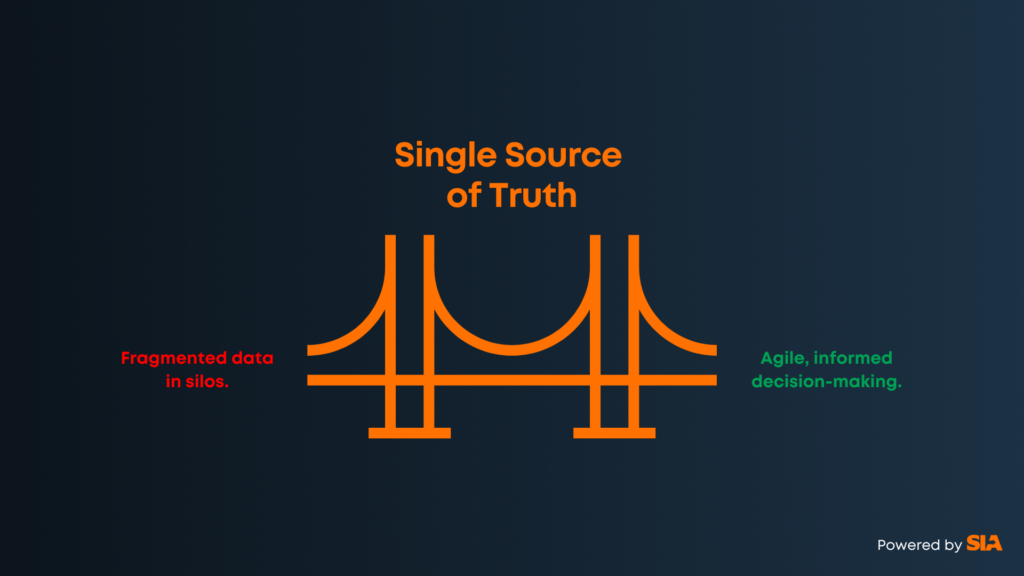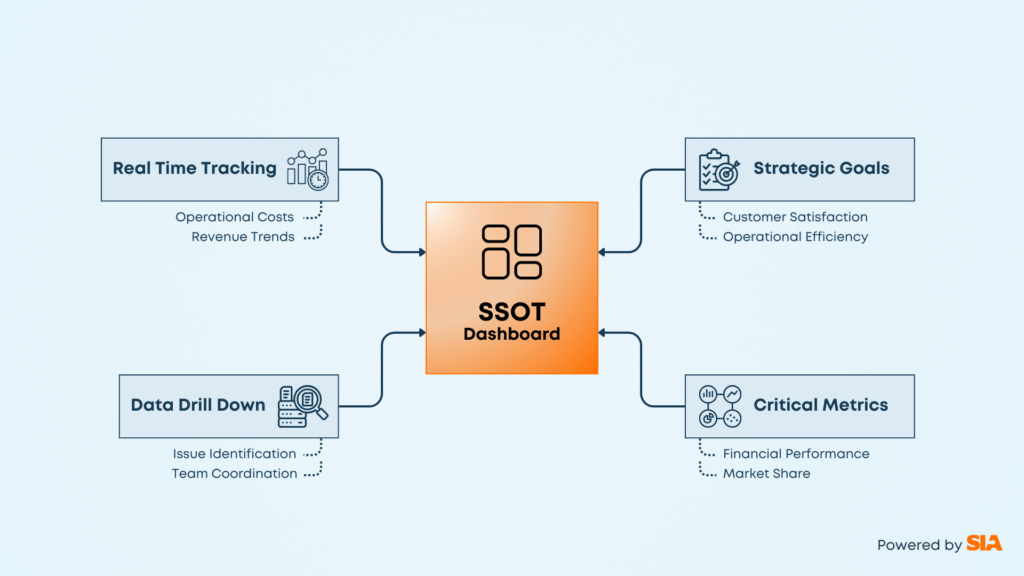
In today’s fast-paced and data-driven business landscape, CEOs and senior leaders face a common obstacle: making informed, strategic decisions without a clear, unified view of organisational data. Siloed information can obscure the big picture, hindering leaders from quickly and effectively aligning their teams with corporate goals. Fragmented data, often buried within departments and stored across different systems, complicates decision-making, wastes time, and limits leaders’ ability to act with agility.
A Single Source of Truth (SSOT) is no longer a luxury—it’s an operational and strategic necessity. By consolidating data into one accessible, accurate, and real-time repository, an SSOT empowers leaders to move beyond data silos, making agile, well-informed decisions with confidence.
Leaders today have access to more data than ever before—customer insights, financial performance metrics, market trends, and more. But instead of enhancing decision-making, this sheer volume of information often creates complexity. Insights are scattered across systems, requiring manual reconciliation and forcing executives into the role of data analysts, not decision-makers. In fact, reports indicate that 37% of data leaders spend more time managing data complexity than generating actionable insights, a troubling reality in an era of data-driven decision-making.
Consider a CEO preparing for a board meeting to review key strategic initiatives. Rather than consulting a consolidated, accurate report, they must juggle summaries from finance, CRM, and operations dashboards—each presenting data with its own definitions and metrics. This inefficient setup delays decisions and turns meetings into debates over data accuracy, rather than focusing on strategy.

A Single Source of Truth (SSOT) consolidates organisational insights, giving CEOs and executives a consistent, reliable view of critical metrics in real time. Beyond being a data tool, an SSOT functions as a strategic asset, helping to:
Enable a Unified View for Strategic Alignment
With an SSOT, leaders have immediate access to accurate, standardised information across departments, making it easier to align teams and unify focus on company objectives.
Foster Trust and Collaboration Across Teams
An SSOT creates a “single data language” across the organisation, minimising miscommunication and enabling departments to collaborate more effectively on shared goals.
Promote Proactive, Agile Decision-Making
SSOT enables leaders to monitor trends, risks, and opportunities as they emerge, allowing quick, strategic adjustments rather than reactive measures.
Reduce Operational Risk and Improve Data Accuracy
By centralising data, SSOT helps eliminate inconsistencies and redundancy, leading to fewer errors and building confidence that decisions are based on the most current information.

A well-designed SSOT dashboard becomes an essential interface for leaders—a “command centre” that enables real-time tracking of critical metrics and seamless visibility into strategic goals. Picture a CEO logging into their dashboard and instantly accessing key data points like revenue, customer satisfaction, and operational efficiency. If they notice an increase in operational costs, they can quickly drill down to identify the cause and coordinate with relevant teams to address issues before they impact overall performance.
Much like a fighter pilot’s head-up display, which consolidates speed, direction, and altitude in one view, an SSOT dashboard integrates everything leaders need for strategic oversight, allowing them to make data-backed adjustments at a glance.
Implementing an SSOT requires strategic planning, data governance, and, often, an investment in technology. To create a robust SSOT, CEOs can follow these essential steps:
Map out where critical information resides across departments, including finance systems, CRM platforms, and operational databases. Consolidating this data provides the backbone of an SSOT.
Opt for a business intelligence (BI) platform that can integrate multiple data sources in real time, ensuring that insights are accurate and up-to-date.
Establish consistent metrics and definitions across all functions to ensure clarity and comparability. For example, standardise terms like “customer satisfaction” and “retention rate” to eliminate any ambiguity.
A user-friendly, customisable dashboard will allow leaders to access KPIs, strategic goals, and progress updates effortlessly. Tailor the interface to align with your specific business priorities.
Frequent data audits help maintain the accuracy of the SSOT, foster trust in its insights, and reinforce a data-driven culture across the organisation.
Encourage all departments to rely on SSOT data for decision-making. By referencing SSOT data in strategy meetings, leaders can reinforce its value and ensure alignment.

A Single Source of Truth is more than just a solution for data management—it’s a critical asset for modern business leadership. It empowers organisations to transition from reactive to proactive decision-making, aligns teams around shared goals, and creates a foundation for sustainable growth.
In an era where data overload can obscure vision, an SSOT enables CEOs to bring order, clarity, and cohesion to their strategic landscape. Imagine a CEO who, using their SSOT dashboard on a Monday morning, spots a dip in customer satisfaction. Within minutes, they trace the issue to a delay in product shipping, coordinate a response, and monitor improvements—all thanks to the streamlined, real-time insights of an SSOT.
The journey towards an SSOT starts with understanding the organisation’s data landscape. Identify your silos, assess the gaps, and begin building an infrastructure that not only consolidates information but also empowers your team to make faster, better-informed decisions. With an SSOT, you turn data into a strategic advantage, allowing leaders to approach each decision with precision and agility, transforming scattered insights into a clear path forward.
Informatica (2022) Data Fragmentation Is CDO’s Top Challenge in 2022. Available at: https://www.informatica.com/blogs/data-fragmentation-is-cdo-top-challenge-in-2022.html (Accessed: 5 November 2024).
Talend (n.d.) Single Source of Truth: Why It Matters for Data-Driven Decision Making. Available at: https://www.talend.com/resources/single-source-truth/ (Accessed: 5 November 2024).
GetGuru (n.d.) Single Source of Truth: How a Knowledge Management System Helps Companies Create Alignment. Available at: https://www.getguru.com/single-source-of-truth (Accessed: 5 November 2024).
Inriver (n.d.) What is a Single Source of Truth?. Available at: https://www.inriver.com/resources/single-source-of-truth/ (Accessed: 5 November 2024).
Astera (n.d.) Creating a Single Source of Truth for Business Data: Challenges, Benefits & How to Overcome the Obstacles. Available at: https://www.astera.com/knowledge-center/single-source-of-truth/ (Accessed: 5 November 2024).